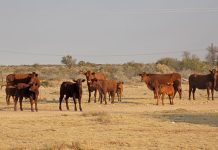Climate change could effect arid biomes so profoundly that the plant and insect diversity we know may disappear in our grandchildren’s time, says Sue Taylor of the World Wildlife Foundation (WWF) Climate Change Programme. While plants can be seed banked or planted elsewhere, insect species can’t. “In any case, it would be impossible to recreate the succulent Karoo, for example, elsewhere,” she points out. “And not all species – plant or animal – could be moved or saved if new land did exist.” C limate change isn’t the only factor at play in insects’ future survival.
“The unprecedented human impact on the environment and the combination of habitat loss and alien species will stress insect species even more, making many of them unable to adapt to new conditions,” Dr Taylor predicts. “Because they play such a big role in natural and farming landscapes, understanding the impacts on insect abundance and diversity is increasingly important.” It’s well known that without bees and other pollinators we’d be without many food and medicinal crops. explains that insects play vital roles in a natural biocontrol system as parasitoids and predators, and in ecosystem nutrient cycling.
“They exist in complex food webs and relationships. With climate change and other global impacts, these relationships could become less complex, destabilise and unravel, with ecosystem consequences that can’t be clearly predicted,” she says. F or farmers, the major concern will be the advance of insect pest species. “At higher temperatures insects move faster and can lay more eggs,” says Dr Taylor. “They also feed more. This could have implications for locust migrations and the movement of the Karoo caterpillar.
A lack of frost in winter will allow pests that have previously been controlled to survive, and warmer winters will allow almost continual breeding and feeding. However, if regions get drier, that might limit insect pests’ activities. “Generally, insect species will be in retreat from the increasing harshness of the SA landscape. However, vectors of diseases, including those linked to human health like mosquitoes, might move to the large metropolitan areas. Malaria surveillance is already being increased, but vectors of veterinary and crop diseases also need to be closely monitored.”
Dr advises farmers to become aware of which pests are “normal” on their farms, and report anything unusual to local agricultural extension officers. “Take photographs or keep samples (frozen or in alcohol) so that specialists can identify any novel insects or arthropod pests and initiate further monitoring work,” she says. She adds there are thousands of economically important insect pest species in the northern hemisphere’s forest and agricultural sectors. “As areas which previously had cold winters start to warm up, pest insects are finding huge new areas to establish themselves, with serious consequences for forestry, agriculture, and native vegetation.”
The Agricultural Research Council and the Plant Protection Research Institute (PPRI) are responsible for maintaining surveillance on known insect pests. The Forest and Agricultural Biotechnology Institute (FABI) at the University of Pretoria also conducts surveillance operations on insects important to forestry and agriculture, and industry-funded research institutes monitor relevant pests. The Centre for Invasion Biology at the University of Stellenbosch researches invasive organisms locally and overseas. Contact Dr Sue Taylor on 082 373 7714 or e-mail [email protected]. |fw








